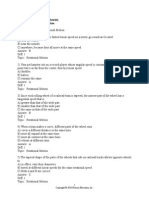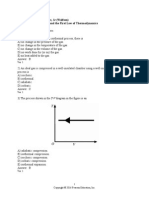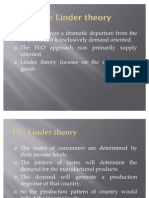0 ratings0% found this document useful (0 votes)
127 viewsChapter 01
Chapter 01
Uploaded by
Michelle HsiehThe document discusses concepts related to science including the scientific method, hypotheses, theories, and facts. It provides examples of how scientists make observations and educated guesses to further knowledge. The document also notes that science, art, and religion each have their own domains and do not contradict one another.
Copyright:
© All Rights Reserved
Available Formats
Download as DOC, PDF, TXT or read online from Scribd
Chapter 01
Chapter 01
Uploaded by
Michelle Hsieh0 ratings0% found this document useful (0 votes)
127 views4 pagesThe document discusses concepts related to science including the scientific method, hypotheses, theories, and facts. It provides examples of how scientists make observations and educated guesses to further knowledge. The document also notes that science, art, and religion each have their own domains and do not contradict one another.
Original Description:
Chap 1
Copyright
© © All Rights Reserved
Available Formats
DOC, PDF, TXT or read online from Scribd
Share this document
Did you find this document useful?
Is this content inappropriate?
The document discusses concepts related to science including the scientific method, hypotheses, theories, and facts. It provides examples of how scientists make observations and educated guesses to further knowledge. The document also notes that science, art, and religion each have their own domains and do not contradict one another.
Copyright:
© All Rights Reserved
Available Formats
Download as DOC, PDF, TXT or read online from Scribd
Download as doc, pdf, or txt
0 ratings0% found this document useful (0 votes)
127 views4 pagesChapter 01
Chapter 01
Uploaded by
Michelle HsiehThe document discusses concepts related to science including the scientific method, hypotheses, theories, and facts. It provides examples of how scientists make observations and educated guesses to further knowledge. The document also notes that science, art, and religion each have their own domains and do not contradict one another.
Copyright:
© All Rights Reserved
Available Formats
Download as DOC, PDF, TXT or read online from Scribd
Download as doc, pdf, or txt
You are on page 1of 4
Conceptual Physics, 11e (Hewitt)
Chapter 1 About Science
1.1 Questions About Science
1) Science is a body of knowledge that
A) describes order in nature.
B) is an ongoing activity of humans.
C) condenses knowledge into testable laws.
D) All of the above choices are correct.
E) None of the above choices are correct.
Answer: D
Diff: 1
Topic: Introduction to Physics
2) Eratosthenes learned about the position of the sun on June 22 by
A) consulting library information.
B) setting up a stick at Syene.
C) setting up a stick at Alexandria.
D) setting up sticks at both Syene and Alexandria.
E) None of the above choices are correct.
Answer: A
Diff: 2
Topic: Introduction to Physics
3) The easiest way for you to measure the distance between the Earth and the moon is to place in
your line of sight to the moon a
A) magnifying glass.
B) coin.
C) telescope.
D) meter stick.
Answer: B
Diff: 2
Topic: Introduction to Physics
4) The safest way for you to view the sun is with
A) a telescope.
B) binoculars.
C) pinhole images.
D) colored sunglasses.
Answer: C
Diff: 2
Topic: Introduction to Physics
1
Copyright 2010 Pearson Education, Inc.
5) The scientific method is most effective in
A) making hypotheses.
B) gaining, organizing, and applying new knowledge.
C) discovering new things.
D) making theories.
E) performing experiments.
Answer: B
Diff: 1
Topic: About Science
6) In science, an educated guess is a
A) hypothesis.
B) theory.
C) both of these
Answer: A
Diff: 1
Topic: About Science
7) In science, facts
A) are absolute.
B) may change.
C) mean very little.
D) are more important than theories.
Answer: B
Diff: 1
Topic: About Science
8) The synthesis of a large collection of information that contains well-tested and verified
hypotheses about certain aspects of the world is known as a scientific
A) fact.
B) hypothesis.
C) law or principle.
D) theory.
E) none of these
Answer: D
Diff: 1
Topic: About Science
9) In science, a theory is
A) an educated guess.
B) less than a fact.
C) a synthesis of a large body of well-tested knowledge.
D) unchangeable.
Answer: C
Diff: 1
Topic: About Science
2
Copyright 2010 Pearson Education, Inc.
10) When a scientist is dishonest and reports false information, he or she
A) like in so many other professions, will be excused by the scientific community.
B) gets no second chance in the scientific community.
Answer: B
Diff: 1
Topic: About Science
11) Which of the following is a scientific statement?
A) The moon is made of green cheese.
B) There are things we will never know about.
C) Matter is filled with undetectable particles.
D) There are parts of the universe that will never be found by man.
E) none of these
Answer: A
Diff: 1
Topic: About Science
12) A scientific hypothesis may turn out to be right or it may turn out to be wrong. If it is a valid
hypothesis, there must be a test for proving it
A) right.
B) wrong.
Answer: B
Diff: 1
Topic: About Science
13) The statement, "There are regions beneath the Earth's crust that will always be beyond the
reach of scientific investigation," is a
A) fact.
B) speculation.
C) hypothesis.
D) scientific statement.
E) theory.
Answer: B
Diff: 1
Topic: About Science
14) Science, art, and religion do not contradict one another because
A) all three have different domains.
B) if you choose the right one, you can forget the other two.
C) if you choose religion and art, you can forget about science.
D) if you choose science, you can forget about religion and art.
Answer: A
Diff: 1
Topic: About Science
3
Copyright 2010 Pearson Education, Inc.
15) A truly educated person is knowledgeable about
A) science.
B) the arts.
C) religion.
D) all of these
Answer: D
Diff: 1
Topic: About Science
16) Science and technology are
A) really one and the same.
B) responsible for all the good in the world.
C) responsible for all the bad in the world.
D) fundamentally different from each other.
Answer: D
Diff: 1
Topic: About Science
17) Of the sciences known as physics, chemistry, and biology, the most basic is
A) physics.
B) chemistry.
C) biology.
D) none in particular, as each may be considered fundamental.
Answer: A
Diff: 1
Topic: About Science
18) Which of the following involves passion, talent, and intelligence?
A) art
B) literature
C) music
D) science
E) all of these
Answer: E
Diff: 1
Topic: About Science
4
Copyright 2010 Pearson Education, Inc.
You might also like
- Practice Exam 2Document13 pagesPractice Exam 2gnotzmNo ratings yet
- Test Bank For Chemistry For Changing Times 15th Edition John W Hill Terry W Mccreary Rill Ann Reuter Marilyn D DuerstDocument39 pagesTest Bank For Chemistry For Changing Times 15th Edition John W Hill Terry W Mccreary Rill Ann Reuter Marilyn D DuerstGeorge Lor100% (43)
- Chapter 3 Kinematics in Two Dimentions Vectors: Physics: Principle and Applications, 7e (Giancoli)Document48 pagesChapter 3 Kinematics in Two Dimentions Vectors: Physics: Principle and Applications, 7e (Giancoli)daminNo ratings yet
- Assignment: Unit 1 Lesson 1 Important PointsDocument3 pagesAssignment: Unit 1 Lesson 1 Important PointsHin Wa Leung100% (1)
- Chapter 17Document12 pagesChapter 17Michelle HsiehNo ratings yet
- Chapter 07Document20 pagesChapter 07Michelle HsiehNo ratings yet
- Wolfson Eup3 ch09 Test BankDocument15 pagesWolfson Eup3 ch09 Test Bank陳禹誌No ratings yet
- Wolfson Eup3 Ch15 Test BankDocument16 pagesWolfson Eup3 Ch15 Test Bankifghelpdesk100% (1)
- 04 TestbankDocument23 pages04 TestbankD Coleman100% (1)
- Wolfson Eup3 Ch24 Test BankDocument13 pagesWolfson Eup3 Ch24 Test BankifghelpdeskNo ratings yet
- Wolfson Eup3 Ch33 Test BankDocument13 pagesWolfson Eup3 Ch33 Test BankifghelpdeskNo ratings yet
- Wolfson Eup3 Ch11 Test BankDocument10 pagesWolfson Eup3 Ch11 Test BankifghelpdeskNo ratings yet
- Physics MC Forces Newtons LawsDocument31 pagesPhysics MC Forces Newtons LawsT W100% (1)
- Chapter 07Document20 pagesChapter 07Michelle HsiehNo ratings yet
- Chapter 11Document11 pagesChapter 11Michelle HsiehNo ratings yet
- Trig P2 Mark SchemeDocument21 pagesTrig P2 Mark SchemeMichelle HsiehNo ratings yet
- 8523827Document2 pages8523827Arora Rameshwar50% (2)
- Test Bank Life in The Universe 3rd EditionDocument6 pagesTest Bank Life in The Universe 3rd EditionRichard1Lauritsen100% (1)
- Chapter 12Document13 pagesChapter 12Michelle Hsieh100% (2)
- Chapter 08Document14 pagesChapter 08Michelle HsiehNo ratings yet
- Chapter 13Document15 pagesChapter 13Michelle Hsieh100% (2)
- Chapter 05Document6 pagesChapter 05Michelle HsiehNo ratings yet
- 4.1 Conceptual Questions: Chapter 4 Dynamics: Newton's Laws of MotionDocument18 pages4.1 Conceptual Questions: Chapter 4 Dynamics: Newton's Laws of MotionnourNo ratings yet
- Ch02test 1DMotionDocument3 pagesCh02test 1DMotionLulun LunkimNo ratings yet
- Chapter 9 Static Equilibrium Elasticity and Fracture: Physics: Principle and Applications, 7e (Giancoli)Document24 pagesChapter 9 Static Equilibrium Elasticity and Fracture: Physics: Principle and Applications, 7e (Giancoli)KarissaNo ratings yet
- CP Phys CH 2 Web RevDocument8 pagesCP Phys CH 2 Web RevMichelle MuliawidjajaNo ratings yet
- Wolfson Eup3 Ch18 Test BankDocument18 pagesWolfson Eup3 Ch18 Test BankifghelpdeskNo ratings yet
- Test Bank 7Document20 pagesTest Bank 7LukeLi100% (1)
- Wolfson Eup3 Ch31 Test BankDocument21 pagesWolfson Eup3 Ch31 Test BankifghelpdeskNo ratings yet
- Simple Harmonic Motion Multiple Choice-2013!07!11Document5 pagesSimple Harmonic Motion Multiple Choice-2013!07!11Vishal NanwaniNo ratings yet
- Wolfson Eup3 Ch08 Test BankDocument12 pagesWolfson Eup3 Ch08 Test BankifghelpdeskNo ratings yet
- hw6 ch7Document5 pageshw6 ch7alpha PapyaNo ratings yet
- VibDocument12 pagesVibChristelle DomingoNo ratings yet
- Wolfson Eup3 Ch09 Test BankDocument15 pagesWolfson Eup3 Ch09 Test BankifghelpdeskNo ratings yet
- 2.1 Conceptual Questions: Chapter 2 Describing Motion: Kinematics in One DimensionDocument29 pages2.1 Conceptual Questions: Chapter 2 Describing Motion: Kinematics in One DimensionnourNo ratings yet
- Final Exam PracticeDocument24 pagesFinal Exam Practicevuhrinek100% (1)
- Chapter 8 Heat Transfer and Change of Phase: Multiple Choice QuestionsDocument9 pagesChapter 8 Heat Transfer and Change of Phase: Multiple Choice QuestionsChantelSantosNo ratings yet
- Applications of Newtons Laws - Practice ProblemsDocument4 pagesApplications of Newtons Laws - Practice ProblemslisagolzarNo ratings yet
- Multiple Choice 3 Circular MotionDocument7 pagesMultiple Choice 3 Circular MotionRazi's Darkz100% (1)
- Wolfson Eup3 Ch30 Test BankDocument8 pagesWolfson Eup3 Ch30 Test BankifghelpdeskNo ratings yet
- Wolfson Eup3 Ch06 Test BankDocument23 pagesWolfson Eup3 Ch06 Test BankifghelpdeskNo ratings yet
- 1.1. SI Units and Their Prefixes MCQ MADocument9 pages1.1. SI Units and Their Prefixes MCQ MAshahbazhu006No ratings yet
- Exam Review 3Document24 pagesExam Review 3api-223793512No ratings yet
- PHY 151 Homework Practice Test Solutions 01Document8 pagesPHY 151 Homework Practice Test Solutions 01Dnhdj JdhsjdNo ratings yet
- Chapter 4 Force and Newtons Laws of MotionDocument23 pagesChapter 4 Force and Newtons Laws of MotionQassem MohaidatNo ratings yet
- Test Practice QuestionsDocument9 pagesTest Practice QuestionsIldjohn CarrilloNo ratings yet
- PhysicsDocument20 pagesPhysicsAnthony HugillNo ratings yet
- Energy Momentum Practice TestDocument11 pagesEnergy Momentum Practice TestMohamad SotoudehNo ratings yet
- PHYSICS 101 Test Bank 2Document24 pagesPHYSICS 101 Test Bank 2Leenie Anne Ang-AngcoNo ratings yet
- 1D Motion With Graphs PDFDocument6 pages1D Motion With Graphs PDFLynn Hollenbeck BreindelNo ratings yet
- Chapter 22 The Birth of The Universe: The Cosmic Perspective, 7e (Bennett Et Al.)Document20 pagesChapter 22 The Birth of The Universe: The Cosmic Perspective, 7e (Bennett Et Al.)mark100% (1)
- Session 6: Circular Motion and Gravitation: Multiple ChoiceDocument4 pagesSession 6: Circular Motion and Gravitation: Multiple ChoiceBipinNo ratings yet
- Chapter 15 Electric FieldsDocument17 pagesChapter 15 Electric FieldsdrewNo ratings yet
- Dynamics Practice Problems-2011!09!28Document21 pagesDynamics Practice Problems-2011!09!28Lester CabungcalNo ratings yet
- 11th Grade Physical Science Test Newton's LawsDocument4 pages11th Grade Physical Science Test Newton's LawsJason JonesNo ratings yet
- Chapter - 8 - Simple Harmonic MotionDocument12 pagesChapter - 8 - Simple Harmonic MotionMohammed Aftab Ahmed0% (1)
- AP Physics Semester 1 ReviewDocument20 pagesAP Physics Semester 1 ReviewAngelo PinerNo ratings yet
- Hapter: Conceptual ProblemsDocument52 pagesHapter: Conceptual ProblemsAmeen ShaikNo ratings yet
- Chapter 06Document13 pagesChapter 06Michelle HsiehNo ratings yet
- Hewitt 60 QuestionsDocument10 pagesHewitt 60 QuestionsEric M. Sullenberger100% (1)
- Wolfson Eup3 Ch04 Test BankDocument21 pagesWolfson Eup3 Ch04 Test BankifghelpdeskNo ratings yet
- 12927Document41 pages12927zoskeroterq2No ratings yet
- Test Bank For Biology A Guide To The Natural World With Mastering Biology 4th Edition by David KroghDocument13 pagesTest Bank For Biology A Guide To The Natural World With Mastering Biology 4th Edition by David Kroghmasonjayden4286No ratings yet
- EnglishDocument2 pagesEnglishSreejith VaneryNo ratings yet
- Chapter 06Document13 pagesChapter 06Michelle HsiehNo ratings yet
- Chapter 05Document6 pagesChapter 05Michelle HsiehNo ratings yet
- Innovation Creativityrevisited 108laedited 160119093558Document31 pagesInnovation Creativityrevisited 108laedited 160119093558Michelle HsiehNo ratings yet
- IB HL Mock Test 2nd NovDocument4 pagesIB HL Mock Test 2nd NovMichelle HsiehNo ratings yet
- Chapter 05Document6 pagesChapter 05Michelle HsiehNo ratings yet
- Implementing Six Sigma Breyfogle PG 381: UV1 UV2 UV3Document2 pagesImplementing Six Sigma Breyfogle PG 381: UV1 UV2 UV3Michelle HsiehNo ratings yet
- Tensile Strength of Paper (PSI) Calcium in Solution (PPM)Document24 pagesTensile Strength of Paper (PSI) Calcium in Solution (PPM)Michelle HsiehNo ratings yet
- IB Math Statistics & ProbabilityDocument4 pagesIB Math Statistics & ProbabilityMichelle HsiehNo ratings yet
- Aiag Gage R&R Part Number Average & Range Met: Required OutputsDocument29 pagesAiag Gage R&R Part Number Average & Range Met: Required OutputsMichelle HsiehNo ratings yet
- IB Math Statistics & ProbabilityDocument4 pagesIB Math Statistics & ProbabilityMichelle Hsieh100% (1)
- IB Math Statistics & ProbabilityDocument4 pagesIB Math Statistics & ProbabilityMichelle HsiehNo ratings yet
- IB Math Statistics & ProbabilityDocument4 pagesIB Math Statistics & ProbabilityMichelle HsiehNo ratings yet
- 10th Dec Complex Numbers ProbDocument4 pages10th Dec Complex Numbers ProbMichelle Hsieh100% (1)
- IB Math Statistics & ProbabilityDocument2 pagesIB Math Statistics & ProbabilityMichelle HsiehNo ratings yet
- Number Theory FB QnsDocument4 pagesNumber Theory FB QnsMichelle Hsieh100% (1)
- IB Math Statistics & ProbabilityDocument4 pagesIB Math Statistics & ProbabilityMichelle HsiehNo ratings yet
- IB Math Statistics & ProbabilityDocument4 pagesIB Math Statistics & ProbabilityMichelle HsiehNo ratings yet
- Chapter 1 Forecasting ARIMA MethodDocument19 pagesChapter 1 Forecasting ARIMA MethodAjit Pal SinghNo ratings yet
- Transformer Age AssessmentDocument7 pagesTransformer Age AssessmentEngr Irfan AkhtarNo ratings yet
- Managerial Report OutlineDocument2 pagesManagerial Report Outlineslipper_crazy5335No ratings yet
- Linear Regression in RDocument7 pagesLinear Regression in Rmeric8669No ratings yet
- Demo Fair TestingDocument30 pagesDemo Fair TestingGem Alaine OjenarNo ratings yet
- Miriam Catterall Qualitative Market ResearchDocument8 pagesMiriam Catterall Qualitative Market ResearchcubanosNo ratings yet
- A Proposal On Consumer Buying BehaviourDocument2 pagesA Proposal On Consumer Buying Behaviournateheavy903No ratings yet
- MCA 504 Modelling and Simulation: IndexDocument138 pagesMCA 504 Modelling and Simulation: Indexpchauhan_47No ratings yet
- Portfolio in Psych Stats - Docx 1Document17 pagesPortfolio in Psych Stats - Docx 1Kate Nicole CruzNo ratings yet
- Chi Square TestDocument75 pagesChi Square Testdrmsupriya091159100% (1)
- Standard Normal DeviateDocument2 pagesStandard Normal DeviateVageesha Shantha Veerabhadra SwamyNo ratings yet
- Enrichment Paper No. 2 Management HistoryDocument4 pagesEnrichment Paper No. 2 Management HistoryVia Maria MalapoteNo ratings yet
- Determination of Heavy Metal Concentration by Atomic Absorption SpectrosDocument2 pagesDetermination of Heavy Metal Concentration by Atomic Absorption SpectrosNandhini D PNo ratings yet
- Analysis of CovarianceDocument4 pagesAnalysis of CovarianceLeo SutrisnoNo ratings yet
- Occupational Schools Regular SchoolsDocument31 pagesOccupational Schools Regular SchoolsEmiraslan MhrrovNo ratings yet
- Activity Sheets: Solving Problems Involving Test of Hypothesis On The Population MeanDocument7 pagesActivity Sheets: Solving Problems Involving Test of Hypothesis On The Population Meandthdtrh100% (2)
- String Theory: Example Sheet 1Document4 pagesString Theory: Example Sheet 1rsanchez-No ratings yet
- Research Methods - I: Scientific Method To Answer The Research QuestionDocument11 pagesResearch Methods - I: Scientific Method To Answer The Research QuestionChitra SuranaNo ratings yet
- IMRa DDocument27 pagesIMRa DPaul Daniel MunozNo ratings yet
- The Linder TheoryDocument13 pagesThe Linder Theorynave16123150% (1)
- Sample Rule of Thumb - 231031 - 074536Document3 pagesSample Rule of Thumb - 231031 - 074536Tiger SuperNo ratings yet
- Post Hoc Tests Familywise Error: Newsom Psy 521/621 Univariate Quantitative Methods, Fall 2020 1Document4 pagesPost Hoc Tests Familywise Error: Newsom Psy 521/621 Univariate Quantitative Methods, Fall 2020 1inayati fitriyahNo ratings yet
- Ratio Estimation (Edited)Document21 pagesRatio Estimation (Edited)Joanne WongNo ratings yet
- Exam - RESEARCH 2nd SemDocument3 pagesExam - RESEARCH 2nd SemMaria Ruffa Dulay IrincoNo ratings yet
- Rynes Bartunek 2017 Evidence Based Management Foundations Development Controversies and FutureDocument29 pagesRynes Bartunek 2017 Evidence Based Management Foundations Development Controversies and FutureMaulana PSamilNo ratings yet
- Bayesian Decision TheoryDocument63 pagesBayesian Decision TheoryBindu Narayanan NampoothiriNo ratings yet
- Penyesuaian Diri Anak Berkebutuhan Khusus Di SMP N 3 Solok SelatanDocument5 pagesPenyesuaian Diri Anak Berkebutuhan Khusus Di SMP N 3 Solok SelatanwatiNo ratings yet
- Cs3353 Foundations of Data Science L T P C 3 0 0 3Document2 pagesCs3353 Foundations of Data Science L T P C 3 0 0 3arunasekaranNo ratings yet
- Livro Simulation Modeling and AnalysisDocument9 pagesLivro Simulation Modeling and AnalysisLuiza Vida50% (2)









































































































